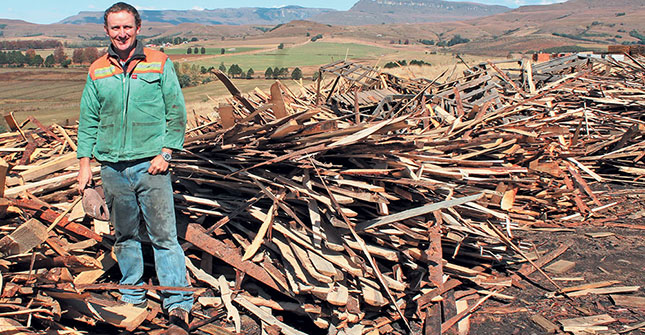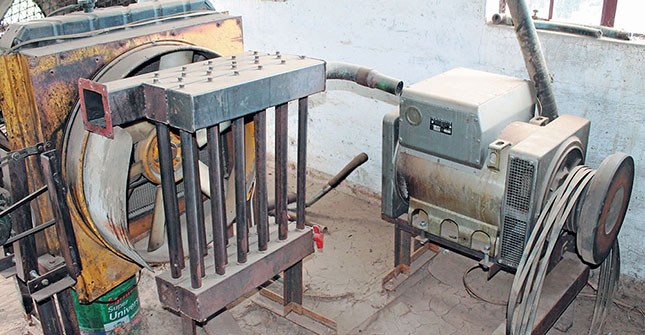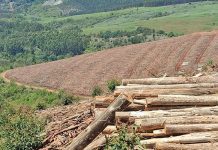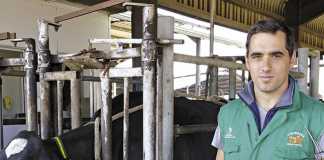
The introduction of regular load-shedding in South Africa a few years ago was a severe blow to the country’s economy. One of the numerous businesses to suffer was the Johnson family’s sawmilling business, Plank-It in KwaZulu-Natal’s Kamberg Valley. The solution? A cost-effective sawmill that runs on wood gas power.
READ: Solar lighting system
The company, Plank-It, began haemorrhaging money due to lost production and an unproductive labour force, as electrical sawmilling machinery stood idle for days on end.
However, this was just the motivation that sawmiller, farmer and mechanical engineer Patrick Johnson needed to find a cost-effective and sustainable solution to the problem.
“Our sawmill generates about 4t of offcuts and other wood waste per day. Previously, when the waste pile became too big we’d simply burn it.
But with the effects of load-shedding, I began researching the possibility of using this wood waste to somehow power the sawmill instead of relying on Eskom’s erratic power supply,” he recalls.
Equipped with a mechanical engineering qualification, the Internet, and a passion for tinkering, Patrick was soon studying the practicalities of producing energy from the gasification of renewable resources.
To his surprise, he discovered a number of like-minded wood gasification enthusiasts around the world. Many were willing to share their ideas, and put Patrick on the trail of existing, albeit often outdated, wood gasification-to-energy designs.
“I originally began focusing on the World War II-era Imbert gasifier design. This was popular among Europe’s civilian population during the war when fossil fuels were scarce. Many of these people ran their personal vehicles on wood gas. Interestingly, Henry Ford’s first vehicle engine was even designed around the wood gas system,” Patrick explains.
The Imbert gasifier
Armed with this knowledge, Patrick built an Imbert gasifier from scratch on his family’s Sans Souci farm. He describes it as an open-top, down-draft gasifier that required a continuous feed of wood chunks, ranging from the size of a matchbox to that of a cigarette box, as fuel.
However, a major drawback of this design was that it could not achieve the minimum 1 200°C required to crack the incombustible water (H2O) molecules in the wood fuel into combustible hydrogen (H) and the oxygen (O) required to keep the reaction burning.
One of the main problems was that the ambient temperature air flowed continuously into the top of the gasifier, preventing the temperature in the combustion chamber from reaching 1 200°C.
“Valuable heat energy was being robbed from the combustion of the wood chunks,” explains Patrick. “So the wood-to-wood gas reaction in the Imbert design was inefficient and wasteful.
“I was trying to use a Chevrolet 4,1l straight-six engine to power the sawmill via an alternator. But I couldn’t get the engine to run continuously without developing one or other major mechanical problem. Condensation of the tar from the wood chunks would often clog the engine’s piping and its intake manifold, freeze its valves, and result in bent pushrods.”
Ironing out problems
Patrick’s ongoing research to overcome these difficulties received a boost when he discovered DriveOnWood. Communicating with other forum members, he gained access to information he had not previously seen.
- For example, he discovered that the original Imbert design was termed a “cold” gasifier and that he needed to increase the combustion temperatures by somehow conserving heat energy throughout the wood gasification process.
At the same time, he came across a wood gasifier developed by US-based Wayne Keith, a well-known farmer and pioneer in this field. Patrick immediately realised that this was what he had been looking for.
“The Wayne Keith system salvages heat from the outgoing gas and uses it to preheat the air entering the gasifier from the atmosphere to approximately 700°C. His system requires wood chunks to be fed into the gasifier in batches. I built a 400l-capacity hopper that could take 150kg of wood chunks at a time,” Patrick says.
Critical to the success of any wood gas system is using only wood chunks with a maximum moisture content of 15%, he adds.
Insulation
The Wayne Keith system uses a triple-insulated fire-tube, and Patrick has added rock wool and vermiculite – rated up to 500°C – to insulate the base of his fire-tube.
“The ambient temperature air drawn down into my Wayne Keith system passes through a heat-exchanger that increases the air’s temperature to between 500°C and 700°C before it enters the fire tube. The wood chunk hopper is hermetically sealed between batch feeds, so no cool air enters to rob the system of thermal units.”
Unfortunately, the gasifier has to be opened every four hours to be fed with another 150kg batch of wood chunks. This causes an almost immediate 200°C temperature drop in the fire tube. It is therefore important to feed the gasifier and seal the hopper again as fast as possible.
- The engine draws wood gas from the gasifier. This consists of 20% to 25% H, 20% to 23% carbon monoxide (CO), 3% to 5% methane (CH4), 2% to 3% carbon dioxide (CO2), and roughly 50% nitrogen (N). The oxygen reacts with the combusting wood to produce CO.
- Before the wood gas reaches the engine’s own combustion chamber, this gas must pass through a filtration system to remove microscopic carbon-based soot particles.
“The stationary engine that powers my sawmill operates for about 10 straight hours a day at peak loads, so it must have a highly effective filtration system. It was a struggle to find the most effective material for this. I tried the various recommendations of hay, sawdust, water impingement, oil impingement, and a forced shower system. None of these worked well enough,” Patrick says.

Going back to his research, he discovered Nomex filter cloth, a DuPont product used by coal-fired power stations for emissions’ scrubbing. It can handle temperatures of up to 230°C, and is fine enough to remove 99% of the soot particles from the gasifier. After this hot filtration process, the wood gas passes through a cooling rack to enter the engine at ambient temperature, allowing it to operate at optimal efficiency.
Patrick points out that a petrol-fuelled engine is only 23% to 25% efficient, primarily due to the large quantity of energy lost through heat generation. By comparison, the wood gas-fed engine is 38% efficient because it runs at a lower temperature than when fuelled with petrol.
“However, due to the low calorific value of wood, its varied moisture content, and the differing characteristics of different types of wood, wood contains 50% less energy than petrol pound-for-pound,” he explains.
Patrick’s 4,1l Chevrolet engine is rated at 130kW output at standard sea level temperature and air pressure, while being fuelled by petrol. However the engine now has to operate at San Souci Farm’s altitude of 1 560m above sea level and at a resulting air pressure of approximately 980 millibars.
These factors, in combination with the lower calorific value of wood, resulted in Patrick only being able to achieve 36kW output from this engine.
This is sufficient, however, to power the sawmill’s two 11kW motors, two 15kW motors, a 10 kW air compressor, as well as a variety of feed motors, live log decks, and other equipment.
The engine is unable to accommodate any sudden large power draws such as motor start-ups, and unexpected power draws such as from the 10kW power-washer.
To reduce these effects, Patrick installed a soft-start system, incorporating variable-speed drives, in the sawmill.
He uses an automatic voltage- regulating alternator between the wood gas-powered engine and the sawmill. It produces 380V between phases, and 230V between phase and neutral. Power from the alternator is at a frequency of 50Hz to 55Hz (Eskom power is at 48Hz and 52Hz).
“My sawmill is powered by 300kg/day of wood waste that would otherwise have been burned. One kilogram of wood chunks, when combusted in my gasifier and used to power the engine, generates 1kW/h of absolutely free and renewable energy,” Patrick says.
Ever seeking improvements, he has dismantled the original gasifier and wood gas-powered engine, and is now constructing an even more efficient and powerful wood gas energy system for his sawmill.
Phone Patrick Johnson on 082 831 0129 or email [email protected]. Visit the Plank-It website here.
This article was originally published in the 17 June 2016 issue of Farmer’s Weekly.













